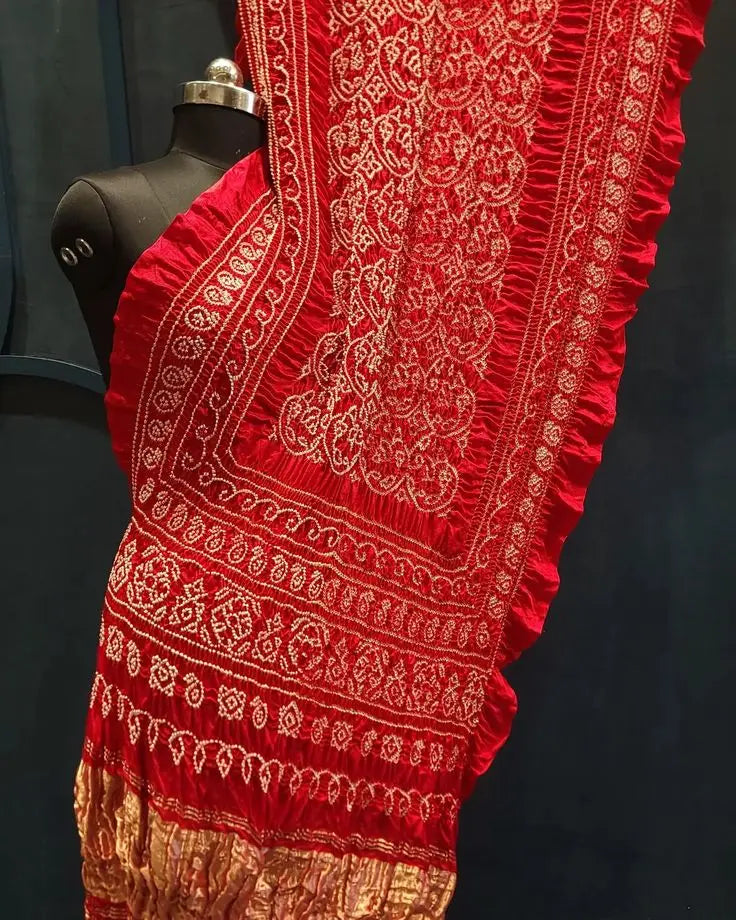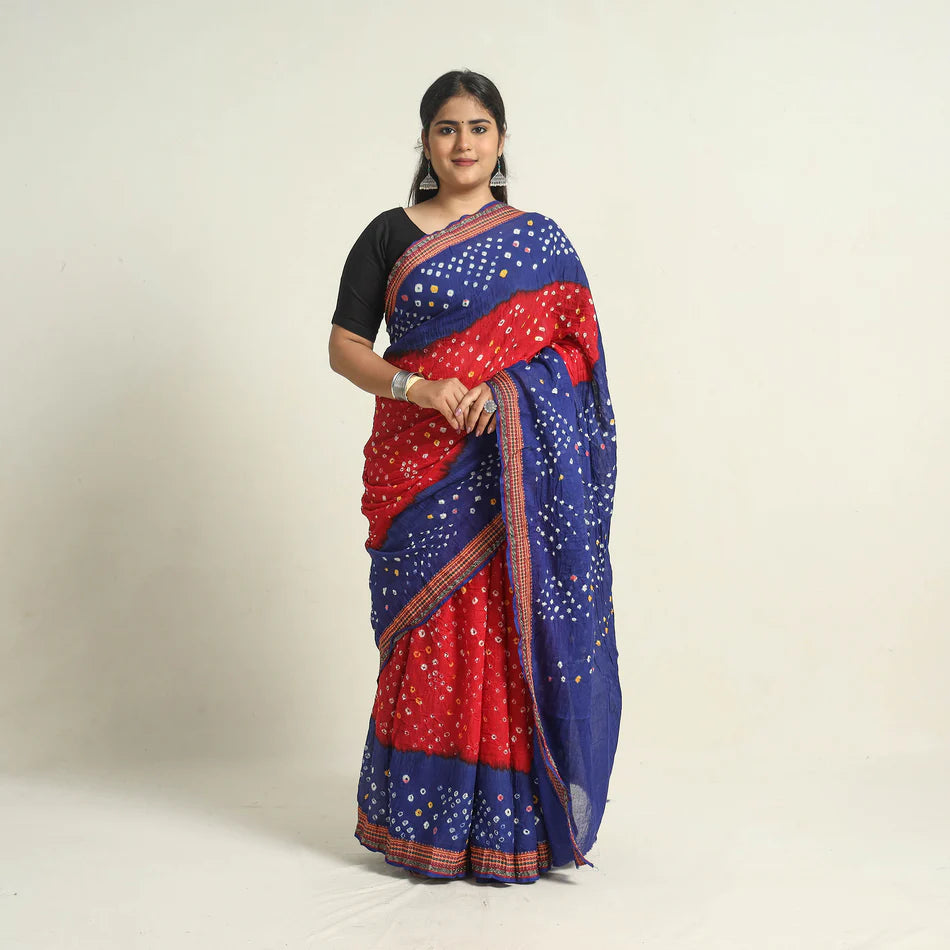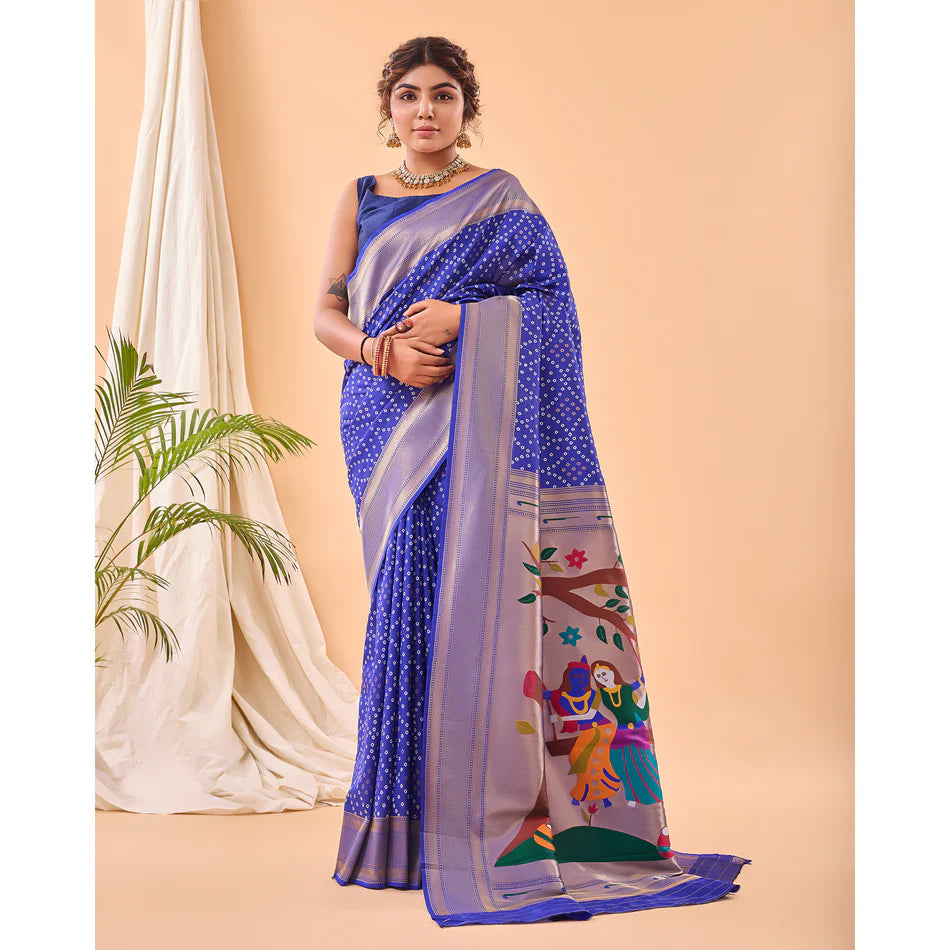Bandhani Saree is a traditional attire from the land of Gujarat that is known for its vibrant colours and intricate designs. In this blog post, we will explore the rich history and cultural significance of the Bandhani Saree, the process of Tie & Dye, different varieties and patterns of Bandhej Saree, occasions when Bandhej Saree is worn, and tips for caring for this beautiful attire.
History of Bandhani Saree
Bandhani Sarees' long and rich history dates back to the 6th century B.C. It is believed that the technique of Tie & Dye was brought to India by the Persians and was later adopted by the Rajputs of Rajasthan and Gujarat. "Bandhani" comes from the Sanskrit word "bandhana," which means to tie. Bandhani Saree is also known as Bandhej Saree or Bandhani Saree.
In ancient times, Bandhani Saree was worn by women as a symbol of prosperity and good luck. The saree's intricate designs and vibrant colours were believed to ward off evil spirits and bring good fortune. Today, Bandhani Saree is still considered a symbol of prosperity and is worn on special occasions like weddings, festivals, and other celebrations. In the age of e-commerce, today, you can easily get Bandhni Sarees Online.
Bandhani Saree Making Technique: Using the Art of Tie and Dye
Bandhani uses a traditional tie and dye technique to create beautiful patterns on fabrics like sarees, dupattas, and salwar kameez. The process involves tying small portions of the fabric with a thread and then dyeing it in bright colours.
Here are the steps involved in making a Bandhani saree:
- Preparing the Fabric: The first step in making a Bandhani saree is to prepare the fabric. The fabric is washed and dried before the dyeing process. The fabric is then spread flat and marked with small dots using chalk or pencil. These dots will serve as a guide for the tying process.
- Tying the Fabric: Using a Kantha technique, the fabric is tied tightly with a thread at specific points. Different styles of tying are used to create different patterns. Some popular styles include 'chunari,' 'leheriya,' 'shikari,' and 'mamra.' The tying process is intricate and requires skill and patience.
- Dyeing the Fabric: Once the fabric is tied, it is time to dye it. The fabric is dipped in a large pot of dye and left to soak for a few minutes. The dye penetrates the fabric in untied portions, creating a beautiful pattern. The fabric is then washed in cold water to remove any excess dye.
- Untying and Finishing: After the fabric is washed, the tied threads are carefully removed, revealing the pattern created by the dye. The fabric is then dried in the sun and repeated until the desired colour intensity is achieved. The fabric is then ironed and stitched into a saree.
The Tie and Dye technique used in making a Bandhani saree is a labour-intensive process requiring much skill and patience. The process has been practised for centuries and is still popular today, especially in Gujarat and Rajasthan, where it originated. The result is a beautiful, colourful, and unique saree that is a work of art.
Designs and Patterns of Bandhani Sarees
The Bandhani saree, also called the "Bandhej," is recognisable due to its unique pattern of small, circular dots. The size and density of the dots can vary depending on the complexity of the design and pattern. Some sarees exhibit a sparse arrangement of larger dots, while others boast a dense and intricate pattern that covers the entire fabric.
Moreover, the colours used in the Bandhej saree are highly diverse. Some sarees may be dyed in a single colour, while others may employ multiple colours to create a lively, attention-grabbing design. The most commonly used colours in the Bandhej saree include red, blue, green, yellow, and pink.
Furthermore, the Bandhej saree is renowned for its elaborate designs and motifs. Certain sarees may feature traditional motifs such as peacocks, elephants, and flowers, while others may showcase contemporary designs and patterns.
Unique Styles of Bandhani Saree and Their Significance
Bandhani Saree comes in different styles and patterns, depending on the region and occasion. Each pattern has a unique significance and is usually worn for specific events or celebrations.
Leheriya Bandhani Saree is a popular style that originated in Rajasthan. The term 'Leheriya' means waves, and the pattern resembles the movement of waves in the ocean. The colour combination used in Leheriya Saree is usually bright and vibrant, making it perfect for festive occasions like weddings and Navratri.
Gharchola Bandhani Saree is a traditional saree that women commonly wear in Gujarat during weddings and other auspicious occasions. The saree is made by weaving silk and cotton threads in a chequered pattern, then tie-dyed to create a unique design. The most commonly used colours in Gharchola Saree are red and green, representing prosperity and fertility.
Shikari Bandhani Saree is a unique style that originated in Kutch, Gujarat. It is named after the design's hunting motifs, such as elephants, peacocks, and deer. The motifs are created using small dots tied and dyed in a specific pattern. The colours used in Shikari Bandhani Saree are usually earthy and muted, giving it a rustic and traditional feel.

(image credit:- PinPage)
Pancharangi Bandhani Saree is a popular style of Bandhani Saree that originated in Jamnagar, Gujarat. 'Panchrangi' means five colours, and the saree is created using a combination of five colours in a specific pattern. The colours used in Pancharangi Saree are usually bright and vibrant, making it perfect for festive occasions like weddings and Navratri.
Chundadi Bandhani Saree is a traditional saree that women commonly wear in Gujarat. It is made by tie-dyeing the fabric in a specific pattern and then embellishing it with small mirrors or beads. The colours used in Chundadi Saree are usually bright and vibrant, making it perfect for festive occasions like weddings and Navratri.
Ekdali Bandhani Saree is a unique style that originated in Kutch, Gujarat. 'Ekdali' means one spot, and the saree is created using a single large dot, which is tie-dyed in a specific pattern. The colours used in Ekdali Saree are usually muted and earthy, giving it a rustic and traditional feel.
How Contemporary Fashion has Given a Modern Spin to Bandhani Sarees
While the Bandhani sarees remain a popular traditional attire in India, modern designers have also embraced the saree and incorporated it into contemporary fashion. The unique patterns and vibrant colours of the Bandhej saree have inspired fashion designers to create modern, avant-garde designs that incorporate traditional motifs and techniques.
Contemporary Bandhani sarees often feature unconventional colours and designs and may incorporate modern elements such as sequins, beads, and metallic accents. These sarees are often worn by fashion-conscious women who want to showcase their individuality and style while paying homage to tradition.
In recent years, Bandhani sarees have also gained international recognition and have been showcased on runways worldwide. Fashion designers from countries such as the United States, France, and Italy have drawn inspiration from the saree and incorporated it into their collections.

Traditional Yet Trendy: Occasions to Wear a Bandhani Saree
Bandhani Saree is a versatile outfit that can be dressed up or down, depending on the event and personal style. Here are some of the occasions when the Bandhani Saree is commonly worn:
-
Weddings: Bandhani Saree is a popular choice of attire for women during weddings in Gujarat and Rajasthan, especially during the haldi, mehndi, and sangeet ceremonies. The saree is usually paired with traditional jewellery and accessories to complete the look.

-
Festivals: Bandhani Saree is a popular choice of attire for women during festivals like Navratri, Diwali, and Holi. Women often wear bright, bold-coloured sarees with traditional jewellery and accessories to complete the festive look.
-
Religious ceremonies: Bandhani Saree is a traditional attire that reflects women's cultural identity in Gujarat and Rajasthan. Women often wear Bandhani Saree during religious ceremonies like puja, havan, and yagna.
-
Formal events: Bandhani Saree is not just limited to formal events but can also be worn to formal occasions like office parties, social gatherings, and corporate events. Women often choose muted and subtle-coloured sarees for such occasions, paired with elegant jewellery and accessories to complete the formal look.
-
Casual outings: Bandhani Saree is a versatile outfit that can be dressed up or down, depending on the occasion. Women often wear Bandhani Saree for casual outings like shopping, lunch with friends, or family gatherings. The saree is usually paired with minimal jewellery and accessories to keep the look simple and comfortable.
Tips to Keep Your Bandhani Saree Looking Like New
Bandhani (Bandhej Saree) is a delicate fabric that requires special care to maintain its beauty and longevity. Here are some tips for caring for your Bandhani Saree:
- Always wash your saree in cold water and avoid using hot water, as it can cause the colour to bleed and fade.
- Use a mild detergent to wash your saree, and avoid harsh chemicals or bleach, as they can damage the fabric and the colours.
- Do not soak your saree for long periods, as it can weaken the fabric and cause the colours to fade. Wash your saree gently and quickly.
- Avoid wringing or twisting your saree, as it can damage delicate tie-dye work. Instead, gently squeeze out the excess water using your hands.
- Hang your saree to dry in a shaded area, away from direct sunlight. Direct sunlight can cause the colours to fade and weaken the fabric.
- Do not store your saree in a damp or humid place, as it can cause mildew and damage the fabric. Store your saree in a dry, cool place, preferably in a cotton or muslin bag.
- Avoid using a hot iron on your saree, as it can damage the delicate tie-dye work. Instead, use a cool iron or a steamer to remove any wrinkles.
Conclusion
Bandhani Saree is a beautiful traditional attire with a rich history and cultural significance. Whether worn at weddings, festivals, or other special occasions, it is a versatile outfit that can be dressed up or down, depending on the event and personal style. By following the tips for caring for your saree, you can maintain its beauty and longevity for years.
FAQs:
What fabrics are used in Bandhani sarees?
Bandhani sarees are traditionally made with lightweight cotton, silk, and chiffon fabrics. However, nowadays, you can also find Bandhani sarees made with other fabrics such as georgette, crepe, and satin.
Can the tie & dye process be done on silk sarees?
Yes, the tie & dye process can be done on silk sarees. Silk sarees are one of the popular choices for tie & dye because of their smooth texture and ability to hold the colours well.
How to maintain a Bandhani saree?
To maintain a Bandhani saree, it is recommended to dry clean it to retain its colour and texture. If you prefer to wash it at home, you should do it gently by hand and avoid using harsh detergents. Also, dry it in the shade to prevent the colours from fading.
Which city in Gujarat is famous for the Bandhani saree?
The city of Jamnagar in Gujarat is famous for Bandhani sarees. The Bandhani artisans in Jamnagar are known for their intricate tie & dye patterns and designs.
What is special about the Bandhani saree?
Bandhani sarees are special because of their unique tie & dye patterns created by skilled artisans using a traditional technique. The process involves tying small fabric sections with thread and dipping them in vibrant colours to create intricate patterns. The result is a beautiful saree with a distinct texture and design that is truly one-of-a-kind.
How to accessorise a Bandhani saree?
The Bandhani saree is a versatile outfit that can be easily accessed. You can pair it with traditional jewellery such as jhumkas, bangles, and necklaces made of gold or silver. You can add a touch of modernity to your look by opting for contemporary jewellery such as statement earrings, bracelets, and rings. A pair of high heels or a traditional mojari can complete the look.
blogs you might also like
Famous handicrafts of India from 29 States and UTs
How to accessorize your saree: Jewelery, Bags and Foorwear
Brass utensils- The benefits of using Pital utensils
 Verified Purchase
Verified Purchase








































































Leave a comment (all fields required)